Revolution through the lenses of Magnum photographers
- Published
- comments
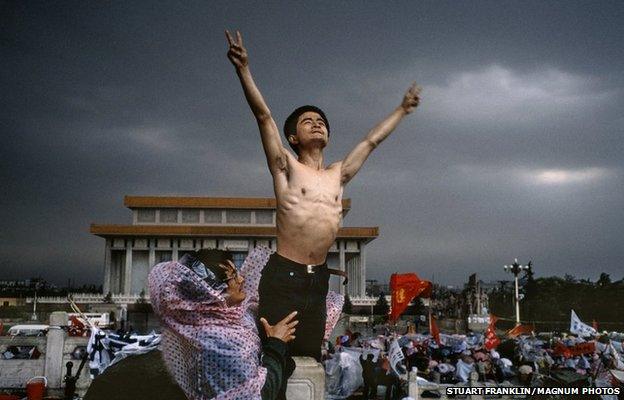
Student protest in Tiananmen Square, China, 1989
Almost since the birth of photography, political unrest and conflict have drawn photographers to capture the drama of the moment, and in some cases to offer comment through their work.
Magnum Photos was brought to life in the aftermath of World War II by photographers Robert Capa, Henri Cartier-Bresson, George Rodger and David "Chim" Seymour, each of whom was well acquainted with covering a changing world, where borders and allegiances were shifting as players set themselves for what was to become the Cold War.
So it is no surprise that the many photographers who have followed in their footsteps continued to do the same, throwing themselves at the heart of revolutions around the globe, from the uprisings in Europe as countries attempted to free themselves from Soviet rule to the more recent Arab Spring.
This work by a select band of photojournalists captures the intensity of the struggle for change and in many cases the tragedy and suffering on both sides of the divide. Yet through the decades the pictures show that at the heart of all revolutions are the people, human voices seeking to change their lot in life. As always, the story is what matters.
Here's a selection from the archives of Magnum Photos; see what you make of them.
Burt Glinn - Cuba
One of the most famous revolutions was the one in Cuba that saw Fidel Castro rise to power, fighting alongside Ernesto "Che" Guevara against the regime led by Gen Batista, finally seizing power when the dictator fled on New Year's Day in 1959.
The pictures from that time show figures who seem larger than life and this one by Burt Glinn depicts Castro delivering a long speech in Santa Clara, the town having been liberated earlier by Che.
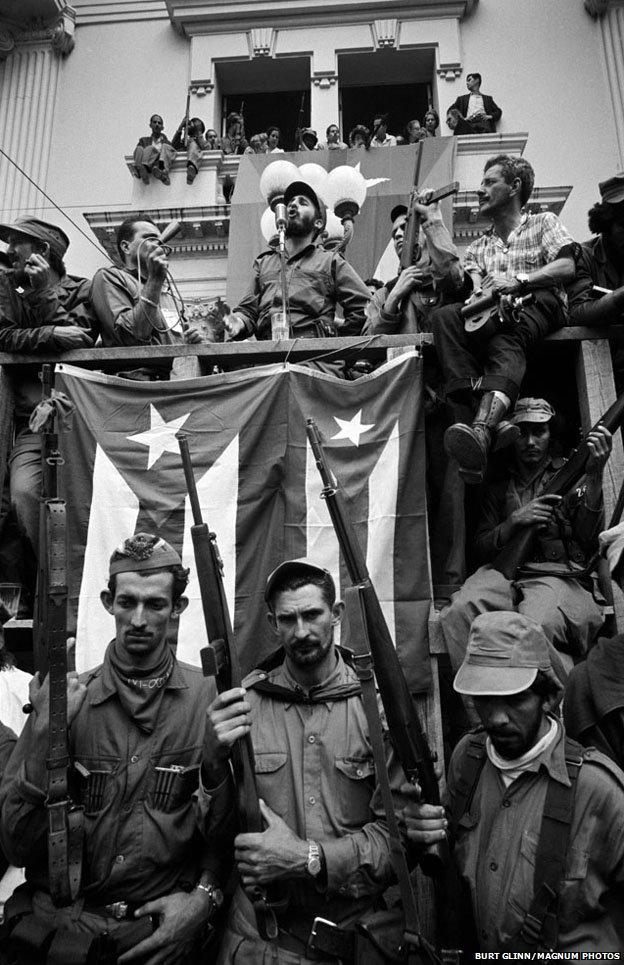
Josef Koudelka - Czechoslovakia
1968 became known as the year of revolution, and Koudelka was on hand that August to record the Soviet-led Warsaw Pact troops' invasion of Czechoslovakia following Alexander Dubcek's Prague Spring.
Koudelka did not see himself as a photojournalist: "What was happening in Czechoslovakia concerned my life directly," he said. "It was my country. That's what made the difference between me and other photographers who came here from abroad. I took these photos for myself, not for a magazine. It was only by chance that they were published."

Abbas - Iran
Abbas was born in Iranian Balichistan but left the country with his family when he was eight years old, returning in 1978 to cover the uprising and staying to be on hand when the Shah was removed from power in 1979. "When the revolution started, it was democratic," says Abbas. "It was my country, my people and my revolution. Then, slowly, it was being hijacked."
Abbas photographed the corpses of four of the Shah's commanders and realised at this point that these executions followed a secret trial. "Something we learned is that the extremists always win. That was my main lesson from the revolution. The extremists were prepared to kill, imprison, torture - everything. So they won."
In this picture a militia woman armed with an Uzi sub-machine gun controls a demonstration against Iraq in Tehran, 1979.
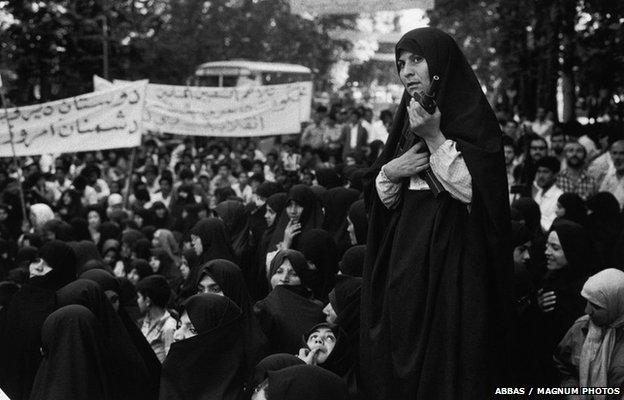
Susan Meiselas - Nicaragua
Susan Meiselas covered the conflict in Nicaragua from the late 1970s which saw the rise to power of the Sandinistas, having overthrown the Somoza regime, swiftly followed by the covert war by US-backed Contra rebels. Meiselas' use of colour adds a powerful punch to her pictures and she is a photographer anyone interested in the field should study. For those who are interested in a previous post, Behind the contact sheet, I look briefly at her working methods alongside other Magnum photographers.
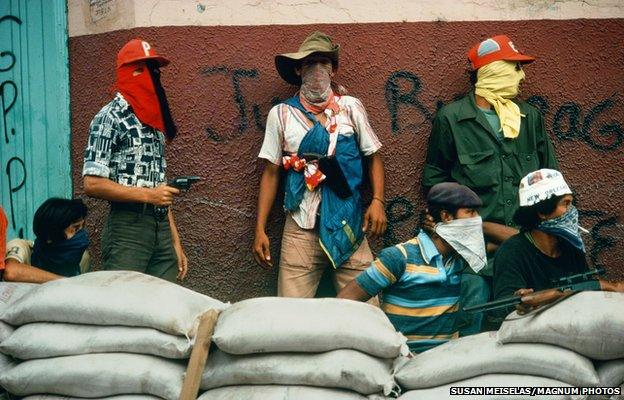
Ian Berry - South Africa
The long struggle for freedom from apartheid in South Africa was documented by Ian Berry, who had joined Magnum in 1962. Like many Magnum photographers he dedicated much of his working life to the story, capturing the deaths of 70 black demonstrators at Sharpeville in 1960 through to the release of Nelson Mandela in 1990 - apart from the eight years when he was banned from the country.
Here, Archbishop Desmond Tutu conducts a funeral service in a tent for a schoolgirl shot by police in 1985. This is what photography is all about. Aesthetically it's a gorgeous picture, yet behind Tutu, look at the faces. Here you see a new generation who will help to finally break the hold of apartheid; decades of struggle are summed up in one frame.

Jean Gaumy - Poland
Poland was the birthplace of the former Soviet bloc's first officially recognised independent mass political movement when strikes at the Gdansk shipyard in August 1980 led to agreement with the authorities on the establishment of the Solidarity trade union.
Here we see relatives of the strikers waiting outside the headquarters of the Gdansk shipyards in 1980. Once again, the photographer has turned the camera on the faces in the crowd, and the use of the barrier adds to the isolation and uncertainty of those pictured, as well as the feeling of being prisoners in their own country.
Yet as with all photographs, all may not be as it seems and Gaumy notes that the mood inside the shipyard, "Solidarity's fortress", was more optimistic.
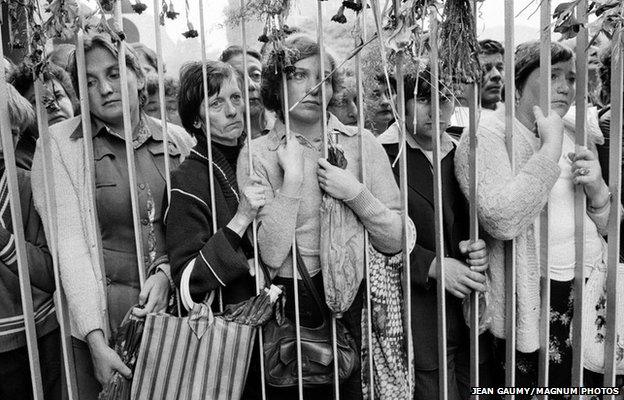
Leonard Freed - Romania
Freed is probably best known for his work on the American civil rights movement yet his coverage of the Romanian revolution of 1989 generated many memorable frames, one of which is this one that depicts a couple sheltering from sniper fire on Christmas Eve in Bucharest. It's an incredibly powerful picture with the fear almost flowing from the frame.
The revolution culminated in the execution of Romania's dictator Nicolae Ceausescu, and his wife, by a firing squad the next day.

Thomas Dworzak - Chechnya
In 2000, Dworzak photographed Chechen fighters dragging a fallen comrade during a mass escape from Grozny through a minefield, following years of conflict with Russian forces, the roots of which were formed when the Soviet Union collapsed in 1991.
Dworzak covered the conflict from 1994, noting that "the intensity of the first war was almost unimaginable. It was crazy, the air war, the flattening of Grozny, the 'filtration camps' - the whole thing."
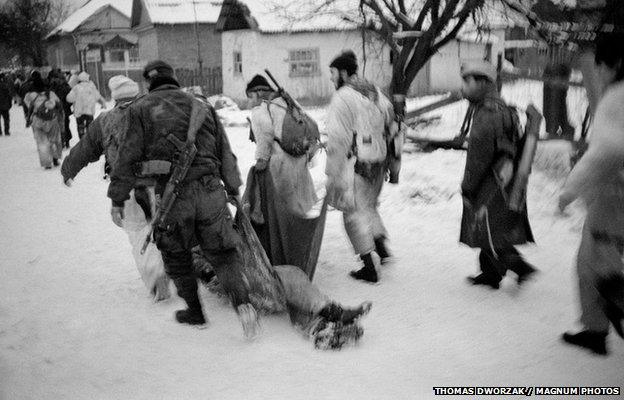
Moises Saman - Arab Spring
Saman is a recent member of Magnum Photos, joining as a nominee in 2010 and becoming an associate this year. He is a regular contributor to the New York Times, Newsweek and Time magazine, among others. He has spent much of the past year or so covering the uprisings in Tunisia, Egypt, Libya and now Syria.
He works at the heart of the action, freezing the exact moment where events have maximum impact and drawing us into the frame. Here a protester with a wound to the head is evacuated on a motorcycle from clashes in Tahrir Square in Cairo, in November 2011. Each figure in the frame is separated from the others creating the perfect composition - and no doubt each one has a story to tell.
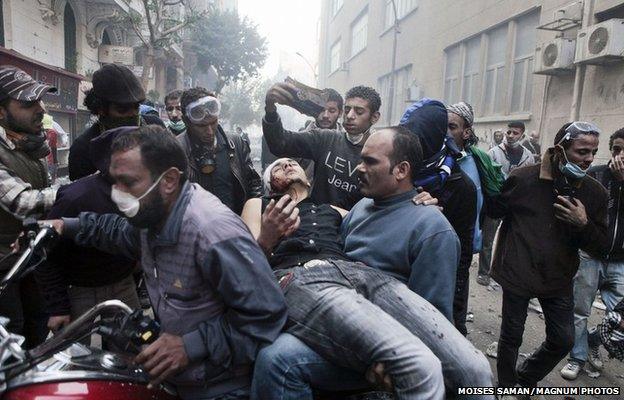
Magnum Revolution: 65 Years of Fighting for Freedom, with an introduction by Jon Lee Anderson and text and interviews by Paul Watson, is published by Prestel.
You can see more work by Magnum Photos on their website, external or you can follow them on Twitter, external.